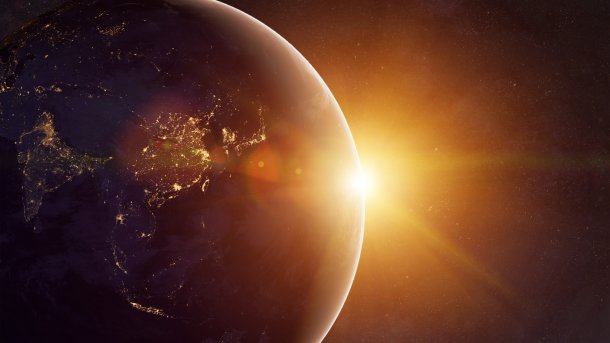"Not science fiction": ESA wants to explore space-based solar energy
ESA is suggesting entry into space-based solar power generation to meet the EU's climate targets. But the costs and risks are high.

(Bild: Skylines/Shutterstock.com)
(Hier finden Sie die deutsche Version des Beitrags)
The European Space Agency (ESA) is bringing the expansion of space-based solar energy into play to achieve the EU's climate goals. In order for Europe to achieve its goal of zero greenhouse gas emissions by 2050, the ESA plans to propose a new programme called "Solaris" to its members later this year. This is meant to prepare the extraction of "Space Based Solar Power" (SBSP) with studies and the development of technologies.
Two analyses by consulting firms, now published by the ESA, attribute huge potential to the generation of solar energy in space. Thanks to the technology, 800 terawatt hours (TWh) of cleaner baseload energy could come from space every year from 2050 onwards, says consulting firm Frazer-Nash. That's equivalent to about a third of all the electricity generated in the European Union in 2020.
High costs, but greater advantages
Space Based Solar Power (SBSP) is a promising solution to the base load problem of renewable energy sources, says the ESA: wind and solar energy depend on the wind blowing or the sun shining. In space, the sun always shines: here, solar energy is generated by positioning satellites with large solar panels in orbit. These continuously convert solar radiation into electricity and send it to Earth via microwaves, for example, where it would be available around the clock as base-load energy. Technically, the basic questions have been clarified, the studies say, but the effort, the costs and the risks are enormous.
In its analysis, the consulting firm Frazer-Nash has compiled several advantages that a large-scale entry into SBSP would bring with it. For example, it could displace oil, gas, solid fuels and even nuclear energy from Europe's energy mix. Europe's dependence on imports for power generation could be reduced to zero by 2050 with 20 satellites larger than the International Space Station (ISS).
Costs of 418 billion euros for use until 2070 would be offset by savings and financial benefits of 601 billion euros. For Germany alone, the net benefit between 2040 and 2070 would amount to 70 billion euros with a comprehensive start.
At the same time, a globally competitive space industry would emerge. For energy generation with satellites, a reusable heavy-lift rocket is needed, such as the one currently being developed by the US company SpaceX with its Starship. In order to set up the system, it would have to be launched more than once a week. SpaceX has proven that this is at least theoretically possible with its Falcon 9.
It would be difficult in this country to find suitable locations for the turbines where the electricity can be transmitted. This would require 70 km2 of land, which is mostly available in the northwest, where more wind power plants are being built. However, the experts believe that this could be remedied by dual use, for example with agriculture.
Scepticism among decision-makers
The second study by Roland Berger also states that SBSP has a high potential to become a competitive renewable technology. However, the relatively high up-front costs and the scepticism at the decision-making level still stand in the way. However, Europe has the opportunity to "acquire technological leadership in the related areas".
Roland Berger also points to the benefits of reusable heavy-lift launchers. Especially in the initial "technology development and design phase", the risk is low. Only the construction phase would become more expensive and risky, but that would only be the case after 2035.
Empfohlener redaktioneller Inhalt
Mit Ihrer Zustimmmung wird hier ein externes YouTube-Video (Google Ireland Limited) geladen.
Ich bin damit einverstanden, dass mir externe Inhalte angezeigt werden. Damit können personenbezogene Daten an Drittplattformen (Google Ireland Limited) übermittelt werden. Mehr dazu in unserer Datenschutzerklärung.
According to this second study, space-based solar power could come to a production cost of €69 per megawatt hour (MWh) for the first plant, and €49/MWh later. This would be in the range of other renewable energies and significantly below nuclear power (91 €/MWh), so SBSP could be competitive. Moreover, the system has the potential to "generate green electricity all year round with little intermittency and no direct greenhouse gas emissions". After preparatory work until 2035, a large-scale programme would then have to begin. This could become the largest energy project ever undertaken by humankind. Both reports are available online in German as summaries and in entirety.
The concept has already been researched for years in the USA and China. The California Institute of Technology (Caltech), for example, will soon test the prototype of a satellite for SBSP in space. In spring, the US Naval Research Laboratory succeeded in transmitting electricity wirelessly over a distance of one kilometre. But all this is still in its infancy, and the ESA now believes that it can catch up with the right funding. Whether the member states will follow suit and contribute the desired money will become clear in November. That is when the ESA ministerial meeting takes place.
(mho)